HLT100 Assessment Task 1: Case Study Analysis of Joyce's Health
VerifiedAdded on 2022/10/03
|10
|2409
|358
Case Study
AI Summary
This case study delves into the health challenges of Joyce, a 77-year-old female, exploring her experiences within a nursing home setting. The analysis comprehensively examines Joyce's medical conditions, including skin breakdown due to fractures and falls, complications related to wound healing, and issues with constipation potentially linked to medication side effects. The study thoroughly investigates osteoporosis, considering its risk factors and impact on Joyce's health. Furthermore, the role of vitamin D supplements in her treatment plan is evaluated. The assignment demonstrates knowledge of the anatomy and physiology of the integumentary, digestive, muscular and skeletal body systems, highlighting the complex interactions between these systems to maintain health and homeostasis in the context of Joyce's case. The analysis draws upon various research sources to support the findings, providing a detailed understanding of Joyce's overall health status and the interconnectedness of her physiological systems.
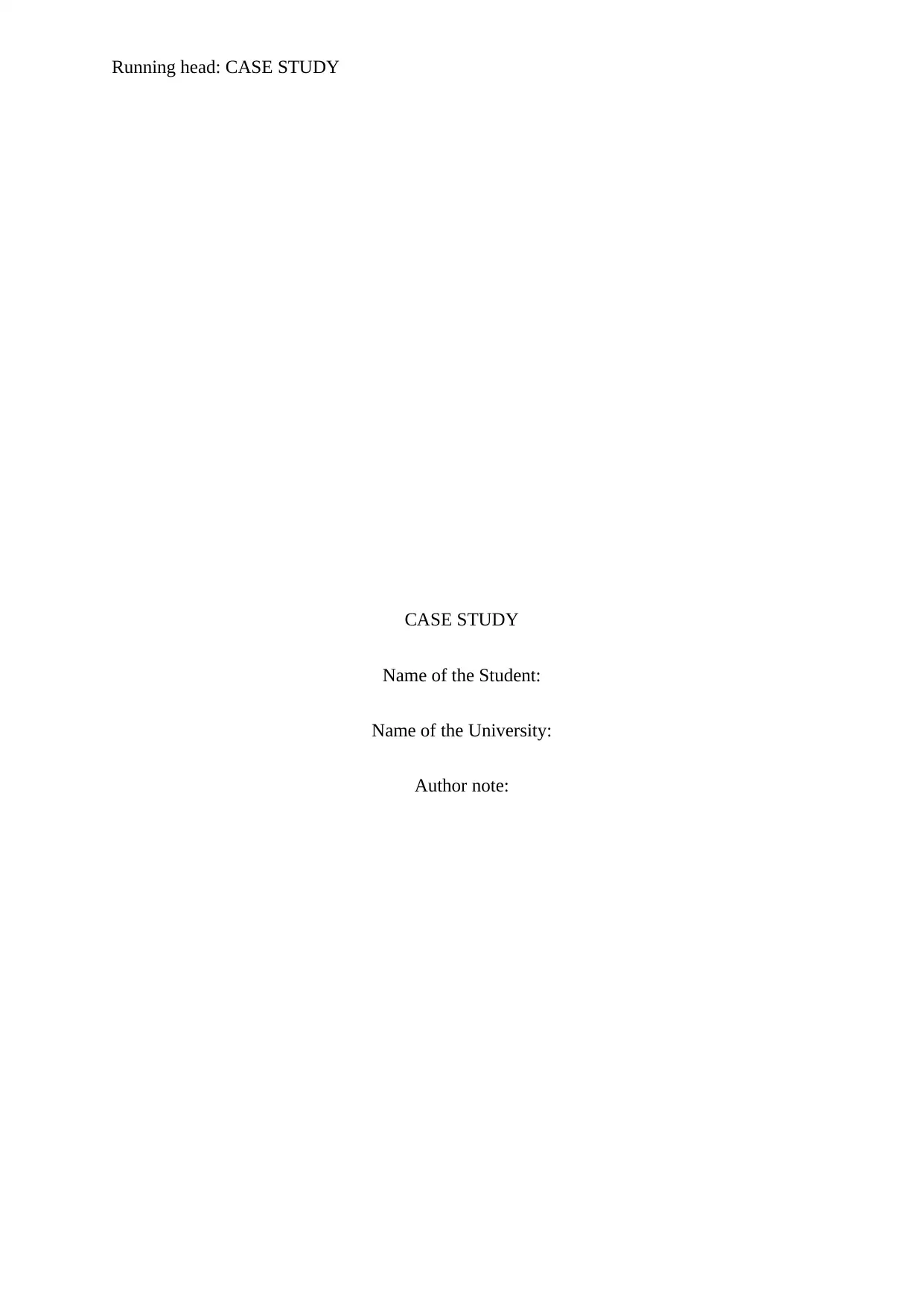
Running head: CASE STUDY
CASE STUDY
Name of the Student:
Name of the University:
Author note:
CASE STUDY
Name of the Student:
Name of the University:
Author note:
Paraphrase This Document
Need a fresh take? Get an instant paraphrase of this document with our AI Paraphraser

1CASE STUDY
Answer 1)
A) This case scenario revolves around the patient, named Joyce, 77 years old female, who
was suffering from fracture and falls that had resulted in the breakdown and injury of skin.
Due to her injury, she was not bale to perform any physical activity in the house to continue
her daily activity of life. According to Campbell, Coyer, & Osborne (2016), skin integrity is
largely affected by an individual’s age, as ageing reduces the total time period required by the
patient to heal the wound. An individual skin is made up of three different layers, where
dermis and epidermis is responsible for resisting and protecting the skin form damage. In
case of older adults, the dermis and epidermis layer of skin reduce their strength and hence
fail to adequately protect the skin from damage. According to Cheung (2017), the number of
Langerhans and keratinocytes cells reduces in number associated with reduction in rate of
epithelisation among the older adults that therefore hampers the skin integrity because these
cells are majorly responsible for maintaining or preserving the skin integrity of an individual.
Hence, the skin of older adults are more prone and susceptible for infection or damage
associated with reduced process of skin healing. In this case study, Joyce was also an older
adult that made her skin loose and she lost her skin integrity with prolonged wound healing
period.
Answer 1)
A) This case scenario revolves around the patient, named Joyce, 77 years old female, who
was suffering from fracture and falls that had resulted in the breakdown and injury of skin.
Due to her injury, she was not bale to perform any physical activity in the house to continue
her daily activity of life. According to Campbell, Coyer, & Osborne (2016), skin integrity is
largely affected by an individual’s age, as ageing reduces the total time period required by the
patient to heal the wound. An individual skin is made up of three different layers, where
dermis and epidermis is responsible for resisting and protecting the skin form damage. In
case of older adults, the dermis and epidermis layer of skin reduce their strength and hence
fail to adequately protect the skin from damage. According to Cheung (2017), the number of
Langerhans and keratinocytes cells reduces in number associated with reduction in rate of
epithelisation among the older adults that therefore hampers the skin integrity because these
cells are majorly responsible for maintaining or preserving the skin integrity of an individual.
Hence, the skin of older adults are more prone and susceptible for infection or damage
associated with reduced process of skin healing. In this case study, Joyce was also an older
adult that made her skin loose and she lost her skin integrity with prolonged wound healing
period.

2CASE STUDY
Source: Cheung (2017)
B) Wound healing is defined as the complex process that involves repairing of the skin and
the tissues present beneath the skin to repair themselves as quickly as possible after any type
of injury. According to Keyes et al. (2016), the older adults have minimum possibility of
wound healing after their skin integrity. The researcher had also documented the age-
associated difference that arise during the wound healing procedure among the older adults.
The complete wound healing procedure is classified into four different sections namely
haemostasis phase, inflammatory phase, proliferative phase and maturation phase. The slow
wound healing process is directly related to the increasing age and affect the cellular and
tissue response that leads to impaired signalling procedure under the activity of cytokine
transduction, unimpeded inflammation, protein imbalance associated with healing and
adverse response towards wound healing (Norman et al., 2016). The inflammatory response
in case of older adults are also delayed that does not permit the white blood cells and required
nutrients to reach the injured cells and repair them, therefore leading to delayed wound
healing. Due to the complete delayed process, the final stage of wound healing takes
approximately 1 month to heal the wound of an older adult, hence, in case of Joyce, she will
take more time to heal the wound because of her age Gould et al. (2015).
Source: Cheung (2017)
B) Wound healing is defined as the complex process that involves repairing of the skin and
the tissues present beneath the skin to repair themselves as quickly as possible after any type
of injury. According to Keyes et al. (2016), the older adults have minimum possibility of
wound healing after their skin integrity. The researcher had also documented the age-
associated difference that arise during the wound healing procedure among the older adults.
The complete wound healing procedure is classified into four different sections namely
haemostasis phase, inflammatory phase, proliferative phase and maturation phase. The slow
wound healing process is directly related to the increasing age and affect the cellular and
tissue response that leads to impaired signalling procedure under the activity of cytokine
transduction, unimpeded inflammation, protein imbalance associated with healing and
adverse response towards wound healing (Norman et al., 2016). The inflammatory response
in case of older adults are also delayed that does not permit the white blood cells and required
nutrients to reach the injured cells and repair them, therefore leading to delayed wound
healing. Due to the complete delayed process, the final stage of wound healing takes
approximately 1 month to heal the wound of an older adult, hence, in case of Joyce, she will
take more time to heal the wound because of her age Gould et al. (2015).
⊘ This is a preview!⊘
Do you want full access?
Subscribe today to unlock all pages.

Trusted by 1+ million students worldwide

3CASE STUDY
Source: Gould et al. (2015)
Answer 2)
A) Joyce was administrated with different types of medication and she was under the risk of
obtaining the adverse side effects of the medication such as constipation or diarrhoea. There
are various types of drugs that can lead to this side effects belonging to different category of
the drug namely chemotherapy medicines, pain medicines, laxative sand antibiotics (Giorgio
et al., 2015). The above mentioned drug interferes with the complete function and structure of
digestive structure such as drawing the complete water to the gut and disturbing the water-ion
channel of the digestive system present in the outer layer of the intestine. These class of drugs
result in contraction of the muscles and tissue of small intestine that result in increasing the
absorption level of water in the intestine and if consumed high dose of above mentioned drug,
the intestinal cells will get adversely affected and van even result in death of intestinal cells
(Marriott, 2018). Hence, the death of intestinal cells swill ultimately lead to the adverse side-
effect of constipation and diarrhoea within the patient. The human digestive system consists
of useful bacteria that is responsible for enhancing the food digestion and maintaining the
water balance, which is also affected by these drugs as they destroy these healthy bacteria and
trigger the development of diarrhoea causing bacteria namely Clostridium difficile (Conlon &
Bird, 2015).
Source: Gould et al. (2015)
Answer 2)
A) Joyce was administrated with different types of medication and she was under the risk of
obtaining the adverse side effects of the medication such as constipation or diarrhoea. There
are various types of drugs that can lead to this side effects belonging to different category of
the drug namely chemotherapy medicines, pain medicines, laxative sand antibiotics (Giorgio
et al., 2015). The above mentioned drug interferes with the complete function and structure of
digestive structure such as drawing the complete water to the gut and disturbing the water-ion
channel of the digestive system present in the outer layer of the intestine. These class of drugs
result in contraction of the muscles and tissue of small intestine that result in increasing the
absorption level of water in the intestine and if consumed high dose of above mentioned drug,
the intestinal cells will get adversely affected and van even result in death of intestinal cells
(Marriott, 2018). Hence, the death of intestinal cells swill ultimately lead to the adverse side-
effect of constipation and diarrhoea within the patient. The human digestive system consists
of useful bacteria that is responsible for enhancing the food digestion and maintaining the
water balance, which is also affected by these drugs as they destroy these healthy bacteria and
trigger the development of diarrhoea causing bacteria namely Clostridium difficile (Conlon &
Bird, 2015).
Paraphrase This Document
Need a fresh take? Get an instant paraphrase of this document with our AI Paraphraser
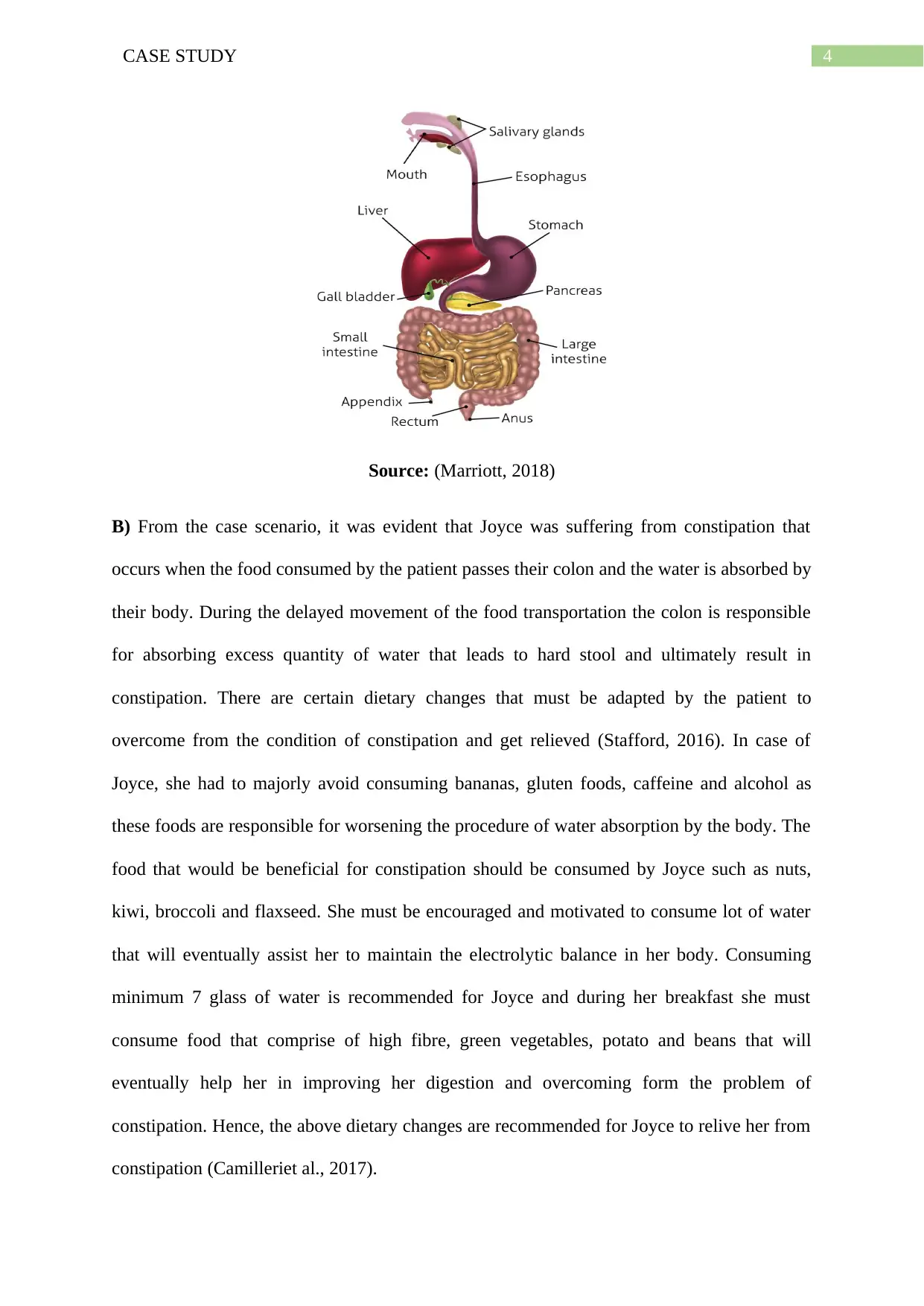
4CASE STUDY
Source: (Marriott, 2018)
B) From the case scenario, it was evident that Joyce was suffering from constipation that
occurs when the food consumed by the patient passes their colon and the water is absorbed by
their body. During the delayed movement of the food transportation the colon is responsible
for absorbing excess quantity of water that leads to hard stool and ultimately result in
constipation. There are certain dietary changes that must be adapted by the patient to
overcome from the condition of constipation and get relieved (Stafford, 2016). In case of
Joyce, she had to majorly avoid consuming bananas, gluten foods, caffeine and alcohol as
these foods are responsible for worsening the procedure of water absorption by the body. The
food that would be beneficial for constipation should be consumed by Joyce such as nuts,
kiwi, broccoli and flaxseed. She must be encouraged and motivated to consume lot of water
that will eventually assist her to maintain the electrolytic balance in her body. Consuming
minimum 7 glass of water is recommended for Joyce and during her breakfast she must
consume food that comprise of high fibre, green vegetables, potato and beans that will
eventually help her in improving her digestion and overcoming form the problem of
constipation. Hence, the above dietary changes are recommended for Joyce to relive her from
constipation (Camilleriet al., 2017).
Source: (Marriott, 2018)
B) From the case scenario, it was evident that Joyce was suffering from constipation that
occurs when the food consumed by the patient passes their colon and the water is absorbed by
their body. During the delayed movement of the food transportation the colon is responsible
for absorbing excess quantity of water that leads to hard stool and ultimately result in
constipation. There are certain dietary changes that must be adapted by the patient to
overcome from the condition of constipation and get relieved (Stafford, 2016). In case of
Joyce, she had to majorly avoid consuming bananas, gluten foods, caffeine and alcohol as
these foods are responsible for worsening the procedure of water absorption by the body. The
food that would be beneficial for constipation should be consumed by Joyce such as nuts,
kiwi, broccoli and flaxseed. She must be encouraged and motivated to consume lot of water
that will eventually assist her to maintain the electrolytic balance in her body. Consuming
minimum 7 glass of water is recommended for Joyce and during her breakfast she must
consume food that comprise of high fibre, green vegetables, potato and beans that will
eventually help her in improving her digestion and overcoming form the problem of
constipation. Hence, the above dietary changes are recommended for Joyce to relive her from
constipation (Camilleriet al., 2017).
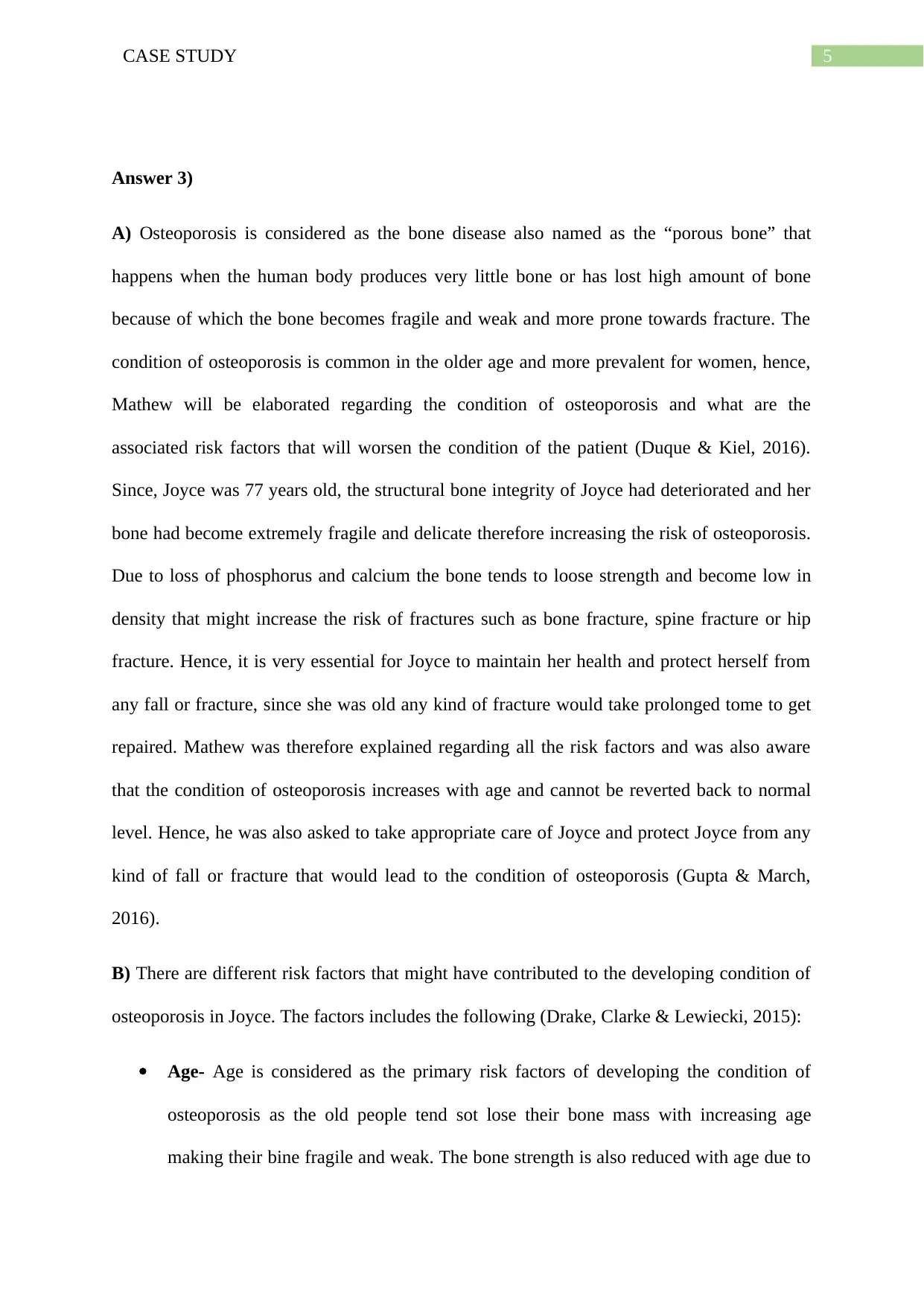
5CASE STUDY
Answer 3)
A) Osteoporosis is considered as the bone disease also named as the “porous bone” that
happens when the human body produces very little bone or has lost high amount of bone
because of which the bone becomes fragile and weak and more prone towards fracture. The
condition of osteoporosis is common in the older age and more prevalent for women, hence,
Mathew will be elaborated regarding the condition of osteoporosis and what are the
associated risk factors that will worsen the condition of the patient (Duque & Kiel, 2016).
Since, Joyce was 77 years old, the structural bone integrity of Joyce had deteriorated and her
bone had become extremely fragile and delicate therefore increasing the risk of osteoporosis.
Due to loss of phosphorus and calcium the bone tends to loose strength and become low in
density that might increase the risk of fractures such as bone fracture, spine fracture or hip
fracture. Hence, it is very essential for Joyce to maintain her health and protect herself from
any fall or fracture, since she was old any kind of fracture would take prolonged tome to get
repaired. Mathew was therefore explained regarding all the risk factors and was also aware
that the condition of osteoporosis increases with age and cannot be reverted back to normal
level. Hence, he was also asked to take appropriate care of Joyce and protect Joyce from any
kind of fall or fracture that would lead to the condition of osteoporosis (Gupta & March,
2016).
B) There are different risk factors that might have contributed to the developing condition of
osteoporosis in Joyce. The factors includes the following (Drake, Clarke & Lewiecki, 2015):
Age- Age is considered as the primary risk factors of developing the condition of
osteoporosis as the old people tend sot lose their bone mass with increasing age
making their bine fragile and weak. The bone strength is also reduced with age due to
Answer 3)
A) Osteoporosis is considered as the bone disease also named as the “porous bone” that
happens when the human body produces very little bone or has lost high amount of bone
because of which the bone becomes fragile and weak and more prone towards fracture. The
condition of osteoporosis is common in the older age and more prevalent for women, hence,
Mathew will be elaborated regarding the condition of osteoporosis and what are the
associated risk factors that will worsen the condition of the patient (Duque & Kiel, 2016).
Since, Joyce was 77 years old, the structural bone integrity of Joyce had deteriorated and her
bone had become extremely fragile and delicate therefore increasing the risk of osteoporosis.
Due to loss of phosphorus and calcium the bone tends to loose strength and become low in
density that might increase the risk of fractures such as bone fracture, spine fracture or hip
fracture. Hence, it is very essential for Joyce to maintain her health and protect herself from
any fall or fracture, since she was old any kind of fracture would take prolonged tome to get
repaired. Mathew was therefore explained regarding all the risk factors and was also aware
that the condition of osteoporosis increases with age and cannot be reverted back to normal
level. Hence, he was also asked to take appropriate care of Joyce and protect Joyce from any
kind of fall or fracture that would lead to the condition of osteoporosis (Gupta & March,
2016).
B) There are different risk factors that might have contributed to the developing condition of
osteoporosis in Joyce. The factors includes the following (Drake, Clarke & Lewiecki, 2015):
Age- Age is considered as the primary risk factors of developing the condition of
osteoporosis as the old people tend sot lose their bone mass with increasing age
making their bine fragile and weak. The bone strength is also reduced with age due to
⊘ This is a preview!⊘
Do you want full access?
Subscribe today to unlock all pages.

Trusted by 1+ million students worldwide
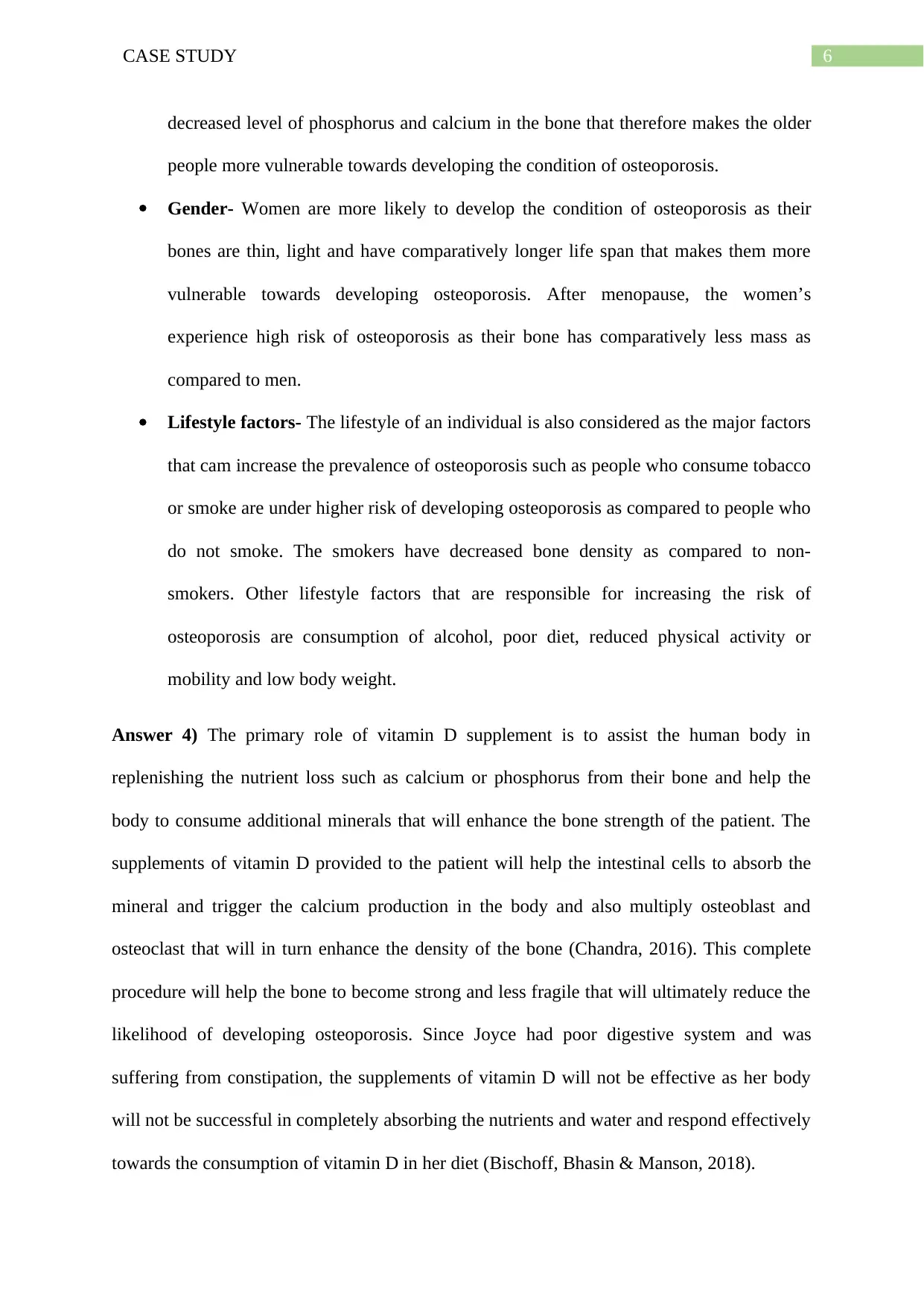
6CASE STUDY
decreased level of phosphorus and calcium in the bone that therefore makes the older
people more vulnerable towards developing the condition of osteoporosis.
Gender- Women are more likely to develop the condition of osteoporosis as their
bones are thin, light and have comparatively longer life span that makes them more
vulnerable towards developing osteoporosis. After menopause, the women’s
experience high risk of osteoporosis as their bone has comparatively less mass as
compared to men.
Lifestyle factors- The lifestyle of an individual is also considered as the major factors
that cam increase the prevalence of osteoporosis such as people who consume tobacco
or smoke are under higher risk of developing osteoporosis as compared to people who
do not smoke. The smokers have decreased bone density as compared to non-
smokers. Other lifestyle factors that are responsible for increasing the risk of
osteoporosis are consumption of alcohol, poor diet, reduced physical activity or
mobility and low body weight.
Answer 4) The primary role of vitamin D supplement is to assist the human body in
replenishing the nutrient loss such as calcium or phosphorus from their bone and help the
body to consume additional minerals that will enhance the bone strength of the patient. The
supplements of vitamin D provided to the patient will help the intestinal cells to absorb the
mineral and trigger the calcium production in the body and also multiply osteoblast and
osteoclast that will in turn enhance the density of the bone (Chandra, 2016). This complete
procedure will help the bone to become strong and less fragile that will ultimately reduce the
likelihood of developing osteoporosis. Since Joyce had poor digestive system and was
suffering from constipation, the supplements of vitamin D will not be effective as her body
will not be successful in completely absorbing the nutrients and water and respond effectively
towards the consumption of vitamin D in her diet (Bischoff, Bhasin & Manson, 2018).
decreased level of phosphorus and calcium in the bone that therefore makes the older
people more vulnerable towards developing the condition of osteoporosis.
Gender- Women are more likely to develop the condition of osteoporosis as their
bones are thin, light and have comparatively longer life span that makes them more
vulnerable towards developing osteoporosis. After menopause, the women’s
experience high risk of osteoporosis as their bone has comparatively less mass as
compared to men.
Lifestyle factors- The lifestyle of an individual is also considered as the major factors
that cam increase the prevalence of osteoporosis such as people who consume tobacco
or smoke are under higher risk of developing osteoporosis as compared to people who
do not smoke. The smokers have decreased bone density as compared to non-
smokers. Other lifestyle factors that are responsible for increasing the risk of
osteoporosis are consumption of alcohol, poor diet, reduced physical activity or
mobility and low body weight.
Answer 4) The primary role of vitamin D supplement is to assist the human body in
replenishing the nutrient loss such as calcium or phosphorus from their bone and help the
body to consume additional minerals that will enhance the bone strength of the patient. The
supplements of vitamin D provided to the patient will help the intestinal cells to absorb the
mineral and trigger the calcium production in the body and also multiply osteoblast and
osteoclast that will in turn enhance the density of the bone (Chandra, 2016). This complete
procedure will help the bone to become strong and less fragile that will ultimately reduce the
likelihood of developing osteoporosis. Since Joyce had poor digestive system and was
suffering from constipation, the supplements of vitamin D will not be effective as her body
will not be successful in completely absorbing the nutrients and water and respond effectively
towards the consumption of vitamin D in her diet (Bischoff, Bhasin & Manson, 2018).
Paraphrase This Document
Need a fresh take? Get an instant paraphrase of this document with our AI Paraphraser

7CASE STUDY
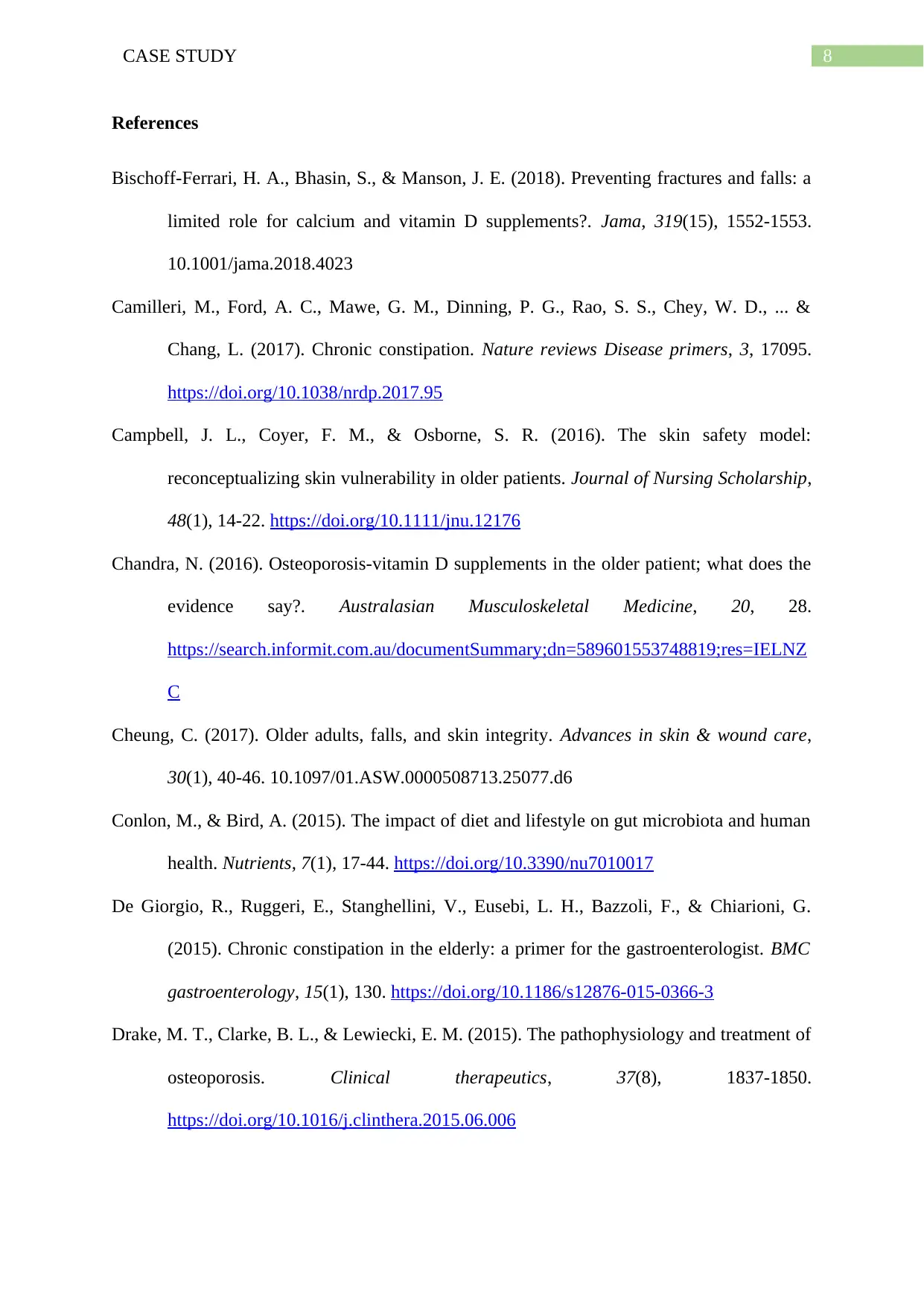
8CASE STUDY
References
Bischoff-Ferrari, H. A., Bhasin, S., & Manson, J. E. (2018). Preventing fractures and falls: a
limited role for calcium and vitamin D supplements?. Jama, 319(15), 1552-1553.
10.1001/jama.2018.4023
Camilleri, M., Ford, A. C., Mawe, G. M., Dinning, P. G., Rao, S. S., Chey, W. D., ... &
Chang, L. (2017). Chronic constipation. Nature reviews Disease primers, 3, 17095.
https://doi.org/10.1038/nrdp.2017.95
Campbell, J. L., Coyer, F. M., & Osborne, S. R. (2016). The skin safety model:
reconceptualizing skin vulnerability in older patients. Journal of Nursing Scholarship,
48(1), 14-22. https://doi.org/10.1111/jnu.12176
Chandra, N. (2016). Osteoporosis-vitamin D supplements in the older patient; what does the
evidence say?. Australasian Musculoskeletal Medicine, 20, 28.
https://search.informit.com.au/documentSummary;dn=589601553748819;res=IELNZ
C
Cheung, C. (2017). Older adults, falls, and skin integrity. Advances in skin & wound care,
30(1), 40-46. 10.1097/01.ASW.0000508713.25077.d6
Conlon, M., & Bird, A. (2015). The impact of diet and lifestyle on gut microbiota and human
health. Nutrients, 7(1), 17-44. https://doi.org/10.3390/nu7010017
De Giorgio, R., Ruggeri, E., Stanghellini, V., Eusebi, L. H., Bazzoli, F., & Chiarioni, G.
(2015). Chronic constipation in the elderly: a primer for the gastroenterologist. BMC
gastroenterology, 15(1), 130. https://doi.org/10.1186/s12876-015-0366-3
Drake, M. T., Clarke, B. L., & Lewiecki, E. M. (2015). The pathophysiology and treatment of
osteoporosis. Clinical therapeutics, 37(8), 1837-1850.
https://doi.org/10.1016/j.clinthera.2015.06.006
References
Bischoff-Ferrari, H. A., Bhasin, S., & Manson, J. E. (2018). Preventing fractures and falls: a
limited role for calcium and vitamin D supplements?. Jama, 319(15), 1552-1553.
10.1001/jama.2018.4023
Camilleri, M., Ford, A. C., Mawe, G. M., Dinning, P. G., Rao, S. S., Chey, W. D., ... &
Chang, L. (2017). Chronic constipation. Nature reviews Disease primers, 3, 17095.
https://doi.org/10.1038/nrdp.2017.95
Campbell, J. L., Coyer, F. M., & Osborne, S. R. (2016). The skin safety model:
reconceptualizing skin vulnerability in older patients. Journal of Nursing Scholarship,
48(1), 14-22. https://doi.org/10.1111/jnu.12176
Chandra, N. (2016). Osteoporosis-vitamin D supplements in the older patient; what does the
evidence say?. Australasian Musculoskeletal Medicine, 20, 28.
https://search.informit.com.au/documentSummary;dn=589601553748819;res=IELNZ
C
Cheung, C. (2017). Older adults, falls, and skin integrity. Advances in skin & wound care,
30(1), 40-46. 10.1097/01.ASW.0000508713.25077.d6
Conlon, M., & Bird, A. (2015). The impact of diet and lifestyle on gut microbiota and human
health. Nutrients, 7(1), 17-44. https://doi.org/10.3390/nu7010017
De Giorgio, R., Ruggeri, E., Stanghellini, V., Eusebi, L. H., Bazzoli, F., & Chiarioni, G.
(2015). Chronic constipation in the elderly: a primer for the gastroenterologist. BMC
gastroenterology, 15(1), 130. https://doi.org/10.1186/s12876-015-0366-3
Drake, M. T., Clarke, B. L., & Lewiecki, E. M. (2015). The pathophysiology and treatment of
osteoporosis. Clinical therapeutics, 37(8), 1837-1850.
https://doi.org/10.1016/j.clinthera.2015.06.006
⊘ This is a preview!⊘
Do you want full access?
Subscribe today to unlock all pages.

Trusted by 1+ million students worldwide
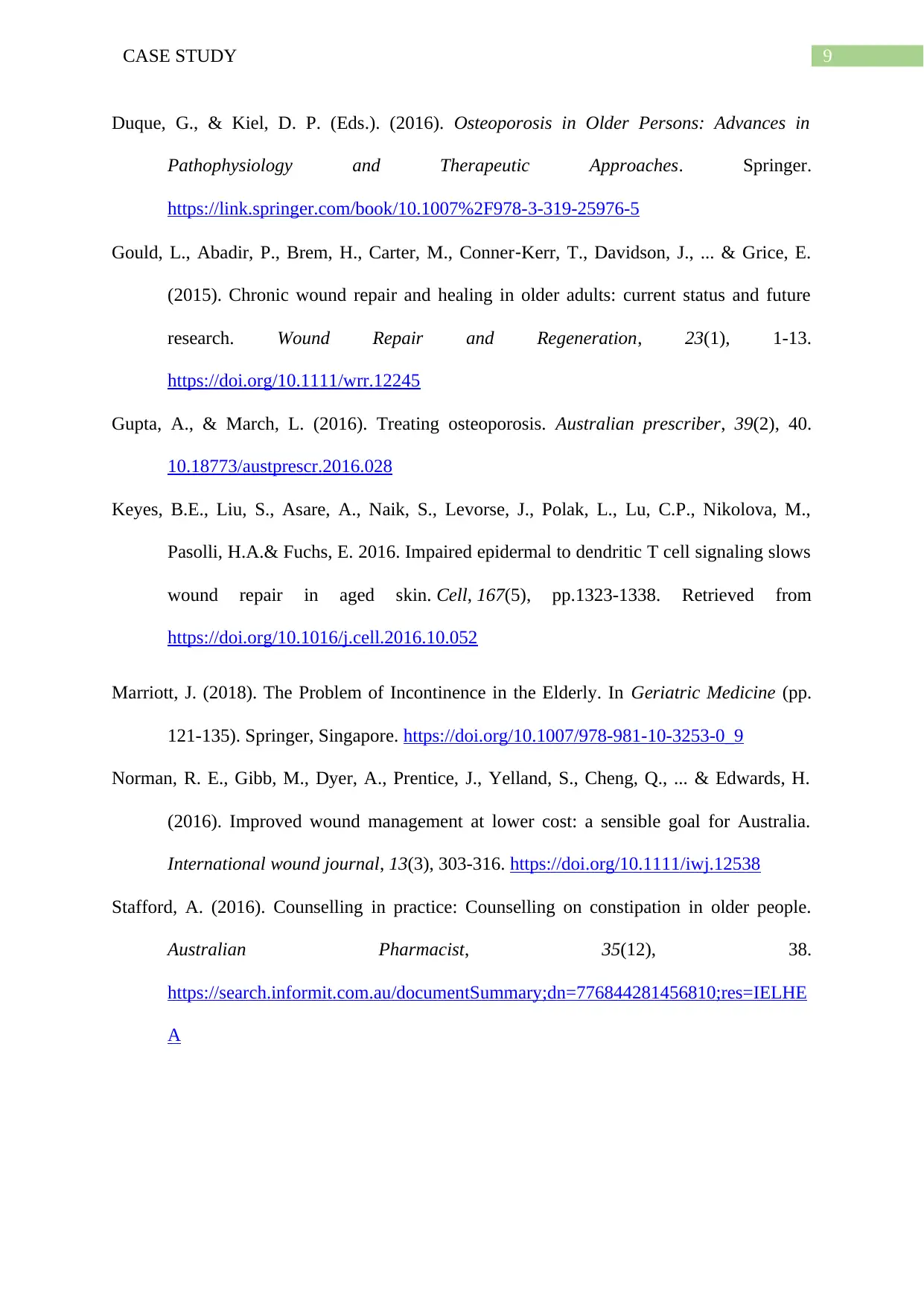
9CASE STUDY
Duque, G., & Kiel, D. P. (Eds.). (2016). Osteoporosis in Older Persons: Advances in
Pathophysiology and Therapeutic Approaches. Springer.
https://link.springer.com/book/10.1007%2F978-3-319-25976-5
Gould, L., Abadir, P., Brem, H., Carter, M., Conner‐Kerr, T., Davidson, J., ... & Grice, E.
(2015). Chronic wound repair and healing in older adults: current status and future
research. Wound Repair and Regeneration, 23(1), 1-13.
https://doi.org/10.1111/wrr.12245
Gupta, A., & March, L. (2016). Treating osteoporosis. Australian prescriber, 39(2), 40.
10.18773/austprescr.2016.028
Keyes, B.E., Liu, S., Asare, A., Naik, S., Levorse, J., Polak, L., Lu, C.P., Nikolova, M.,
Pasolli, H.A.& Fuchs, E. 2016. Impaired epidermal to dendritic T cell signaling slows
wound repair in aged skin. Cell, 167(5), pp.1323-1338. Retrieved from
https://doi.org/10.1016/j.cell.2016.10.052
Marriott, J. (2018). The Problem of Incontinence in the Elderly. In Geriatric Medicine (pp.
121-135). Springer, Singapore. https://doi.org/10.1007/978-981-10-3253-0_9
Norman, R. E., Gibb, M., Dyer, A., Prentice, J., Yelland, S., Cheng, Q., ... & Edwards, H.
(2016). Improved wound management at lower cost: a sensible goal for Australia.
International wound journal, 13(3), 303-316. https://doi.org/10.1111/iwj.12538
Stafford, A. (2016). Counselling in practice: Counselling on constipation in older people.
Australian Pharmacist, 35(12), 38.
https://search.informit.com.au/documentSummary;dn=776844281456810;res=IELHE
A
Duque, G., & Kiel, D. P. (Eds.). (2016). Osteoporosis in Older Persons: Advances in
Pathophysiology and Therapeutic Approaches. Springer.
https://link.springer.com/book/10.1007%2F978-3-319-25976-5
Gould, L., Abadir, P., Brem, H., Carter, M., Conner‐Kerr, T., Davidson, J., ... & Grice, E.
(2015). Chronic wound repair and healing in older adults: current status and future
research. Wound Repair and Regeneration, 23(1), 1-13.
https://doi.org/10.1111/wrr.12245
Gupta, A., & March, L. (2016). Treating osteoporosis. Australian prescriber, 39(2), 40.
10.18773/austprescr.2016.028
Keyes, B.E., Liu, S., Asare, A., Naik, S., Levorse, J., Polak, L., Lu, C.P., Nikolova, M.,
Pasolli, H.A.& Fuchs, E. 2016. Impaired epidermal to dendritic T cell signaling slows
wound repair in aged skin. Cell, 167(5), pp.1323-1338. Retrieved from
https://doi.org/10.1016/j.cell.2016.10.052
Marriott, J. (2018). The Problem of Incontinence in the Elderly. In Geriatric Medicine (pp.
121-135). Springer, Singapore. https://doi.org/10.1007/978-981-10-3253-0_9
Norman, R. E., Gibb, M., Dyer, A., Prentice, J., Yelland, S., Cheng, Q., ... & Edwards, H.
(2016). Improved wound management at lower cost: a sensible goal for Australia.
International wound journal, 13(3), 303-316. https://doi.org/10.1111/iwj.12538
Stafford, A. (2016). Counselling in practice: Counselling on constipation in older people.
Australian Pharmacist, 35(12), 38.
https://search.informit.com.au/documentSummary;dn=776844281456810;res=IELHE
A
1 out of 10
Related Documents
Your All-in-One AI-Powered Toolkit for Academic Success.
+13062052269
info@desklib.com
Available 24*7 on WhatsApp / Email
![[object Object]](/_next/static/media/star-bottom.7253800d.svg)
Unlock your academic potential
Copyright © 2020–2025 A2Z Services. All Rights Reserved. Developed and managed by ZUCOL.





